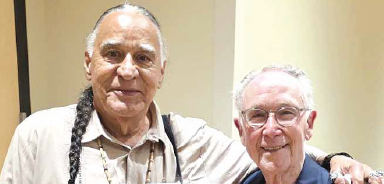
Photo: Navy veterans Ernie Pannicioli (Cree), Hiphop photographer and Jerry Ashton, Founder of End Veteran Debt at Veterans Summit in New York City
End Veteran Debt's inaugural summit at New York City’s Fordham University on 9-9-2025 debuted a most unusual approach to finding and implementing solutions to one of the most intractable healthcare problems that exists in American society today: the suicide rate of its veterans and citizens.
In 2022, the CDC placed America’s age-adjusted suicide rate at 14.4 per 100,000, but certain demographic groups face disproportionately higher rates. In 2023, the highest age-adjusted suicide rates were among non-Hispanic American Indian or Alaska Native people (23.8 per 100,000), followed by non-Hispanic White people (17.6 per 100,000).
Veterans face a significantly higher risk of suicide compared to the non-veteran population. In 2022, the age-and sex-adjusted suicide rate among veterans was 57.3% higher than among non-veteran U.S. adults. Male veterans had a 44% higher rate than non-veteran men, and female veterans had a 92% higher rate than non-veteran women.
This has to change. Fresh solutions must be found and implemented. The Summit was convened to do just that – this time inviting veteran, military, and civilian organizations to pool their knowledge and resources to stoke a national “End Veteran Debt and Suicide Awareness” campaign.
This has to change. We are losing our children, our parents, our friends, and our neighbors. Solutions must be found and implemented as quickly as possible.
The End Veteran Debt summit was convened to do just that – and reached out widely to invite, in particular, civilians to join in the campaign. This outreach included the native American, black, Hispanic, and Asian populations.
What was lost (this time around) was face-to-face access to the subject matter experts
Army Brigadier Michael Eastman, Executive Director of Onward Ops was the lunch keynote speaker. Candyce Bravo, Executive Director NYC Chapter of the American Foundation for Suicide Prevention, Dr. Emily Edwards for Justice-Involved Veterans Program, and Director of Clinical Core VISN 2 MIRECC-VA, and Salvina Barresi, LCSW, VA Community Engagement and Partnership Coordinator/Suicide Prevention Team paneled a discussion on current approaches led by Michael Matthews, LCSW and Director of Veteran Programs for the Staten Island Social Care Network.
Also lost was learning from the “Others ... seemingly outside the conversation, yet essential to it.”
There were the artists. Mike Williams, Army battlefield medic and songwriter, Kerra Renee, President of African-American Women in Cinema, Army (ret.) multi-discipline artist, and famed Hip-Hop photographer, Ernie Paniccioli. All were in the panel led by artist, philanthropist, and veteran booster Steve Alpert. Each embodied in their careers the importance of art in both picturing and healing the pains and trauma leading to self-harm.
There were the bill collectors. If you are going to address debt, it may be useful to learn from those who deal with it on a professional basis. My fellow debt industry executive and co-founder of RIP Medical Debt (since renamed Undue Medical Debt), Craig Antico, and I outlined the steps by which charitable donations can be processed by Craig’s public benefit corporation, ForgiveCo, to become “erased.” Gone. Credit Marks disappeared.
There were the journalists, such as Russell Midori, co-founder of Military Veterans in Journalism (MVJ) who led a panel on the importance of having more veterans employed by print and broadcast media, and the even greater importance of Independent journalism as a powerful alternative to mainstream media in getting out non-spin stories.
There were the outsiders, best exemplified by Dr. Owen Muir of Radial who introduced a solution less known to the VA, “transcranial magnetic stimulation, which the FDA just approved. There were businessmen, exemplified by Richard Bennett of Epicured, a company deeply engaged in bringing healthy meals to offset the food deserts found in veteran and civilian communities.
Missing – the Native American Media, Civilians, and Veterans
(Well, not totally. Famed Hip-Hop photographer Ernie Paniccioli, a Navy veteran and artist of Cree descent, was the solitary voice warning Summit attendees to be concerned about the dangers of the current administration.)
The numbers and statistics
The suicide death rate of American Indian and Alaska Native adolescents (18.95 per 100,000) was the highest of any racial/ethnic group (70.4% greater than non-Hispanic Whites, 239% greater than non-Hispanic Blacks, 284.1% greater than Asians, and 298% greater than Hispanics).
In 2022, suicide was the second leading cause of death for non-Hispanic American Indians/Alaska Natives ages 10–34 Suicides Among American Indian/Alaska Natives — National Violent. AI/AN adolescents averaged one in four contemplated suicides, one in five planned suicides, and one in six attempted suicides
Approximately 70% of AI/AN decedents resided in nonmetropolitan areas, including rural settings, underscoring the importance of implementing suicide prevention strategies in rural AI/AN communities.
The Indian Health Service (IHS), created to provide healthcare to American Indians and Alaska natives, is part of the problem. Severe underfunding, widespread shortages of medical personnel, mismanaged resources, and inefficiencies comprise a general failure to fulfill the federal government’s trust and treaty obligation.

